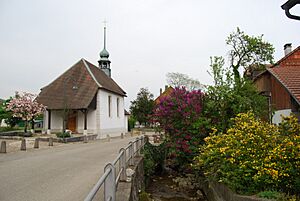Rickenbach, Solothurn facts for kids
Quick facts for kids
Rickenbach
|
||
|---|---|---|
|
||
| Country | Switzerland | |
| Canton | Solothurn | |
| District | Olten | |
| Area | ||
| • Total | 2.76 km2 (1.07 sq mi) | |
| Elevation | 429 m (1,407 ft) | |
| Population
(Dec 2020 )
|
||
| • Total | 1,055 | |
| • Density | 382.2/km2 (990.0/sq mi) | |
| Postal code |
4613
|
|
| Surrounded by | Hägendorf, Hauenstein-Ifenthal, Kappel, Wangen bei Olten | |
Rickenbach is a small town, also called a municipality, in Switzerland. It's located in the Olten district, within the canton of Solothurn.
Contents
History of Rickenbach
Rickenbach is quite old! It was first mentioned in official records way back in 1288. Back then, its name was spelled Richenbach.
Geography of Rickenbach
Rickenbach covers an area of about 2.76 square kilometers (about 1.07 square miles). A big part of this land is covered by forests, about 52.9%. Another 31.2% is used for farming. The rest, about 17.4%, has buildings or roads.
The town is found at the southern base of the Jura Mountains. It sits on a special type of landform called an alluvial fan. This is created by a stream that flows into the Dünnern river.
Rickenbach's Coat of Arms
The blazon (official description) of Rickenbach's coat of arms shows a red shield. On it, there is a silver image of Saint Lawrence. He is standing and holding a grill in his right hand and a palm branch in his left hand.
People and Population in Rickenbach
Rickenbach has a population of around 890 people. About 9.2% of the people living here are from other countries. Over the last 10 years, the number of people in Rickenbach has grown by about 2.5%.
Languages Spoken in Rickenbach
Most people in Rickenbach speak German. About 95.3% of the population uses German as their main language. Other languages spoken include Serbo-Croatian (1.0%) and Italian (0.7%). A few people also speak French or Romansh.
Age Groups in Rickenbach
In Rickenbach, about 7.2% of the population are young children (0-6 years old). Teenagers (7-19 years old) make up about 15.3% of the population. Adults between 25 and 44 years old are the largest group, making up 33.0% of the population. About 10.4% of the people are seniors, aged 65 to 79.
Households and Homes in Rickenbach
There are about 365 private homes in Rickenbach. On average, about 2.4 people live in each home. About 24.7% of homes have just one person living in them. Many homes are lived in by married couples, some with children and some without.
Most of the buildings in Rickenbach are single-family homes. About 70.4% of all inhabited buildings are these types of homes. Many of these homes were built between 1971 and 1980.
The chart below shows how the population of Rickenbach has changed over many years:

Economy and Jobs in Rickenbach
In 2010, Rickenbach had a low unemployment rate of 2.5%. This means most people who wanted to work had a job.
Types of Jobs
Jobs in Rickenbach fall into three main groups:
- Primary sector: This includes jobs like farming. About 9 people work in this area.
- Secondary sector: This includes jobs in manufacturing (making things) and construction. About 362 people work in this sector. Most of these jobs are in manufacturing.
- Tertiary sector: This includes jobs in services, like sales, transportation, hotels, and education. About 407 people work in this sector. Many jobs are in moving and storing goods.
Many people who work in Rickenbach actually travel there from other towns. About 1.6% of these workers come from outside Switzerland. Most people (61.9%) use a private car to get to work, while 11.7% use public transportation.
Religion in Rickenbach
According to a census in 2000, many people in Rickenbach are Christian. About 44.5% are Roman Catholic and 30.7% belong to the Swiss Reformed Church. There are also smaller groups of other Christian faiths. About 2.6% of the population are Islamic. A good number of people, about 14.58%, do not belong to any church or are atheist.
Education in Rickenbach
Education is important in Rickenbach. About 42.9% of the people have finished non-mandatory high school (called upper secondary education). Also, about 13.6% have gone on to higher education, like a university.
In 2000, 43 students from Rickenbach went to schools outside of the municipality.
Famous People from Rickenbach
- Silja Walter (1919–2011): She was a Swiss author and a Benedictine nun.
- Otto F. Walter (1928–1994): He was a Swiss journalist, author, and publisher.
See also
 In Spanish: Rickenbach (Soleura) para niños
In Spanish: Rickenbach (Soleura) para niños






